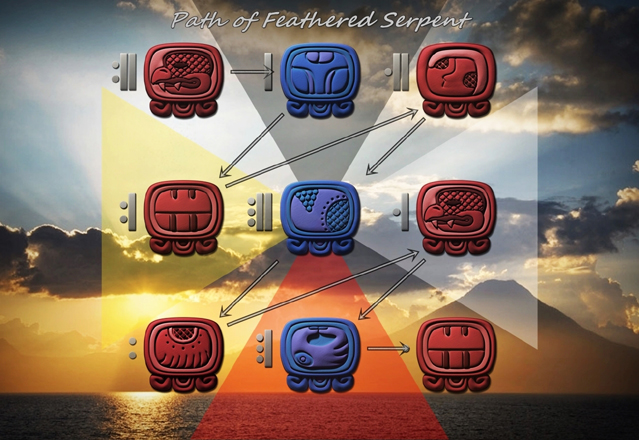by Kenneth Johnson
Illustrated by Erroll James Reykjalin
Lesson 1
The Maya perceive the universe as an energetic whole made up of two opposing but complementary polarities, expressions of a single, unified force. They mirror each other like opposites: Summer and winter, cold and heat, light and darkness. Ultimately, however, they are of the same essence In terms of astrology, the polarities are most clearly seen in the idea that day-signs are masculine whereas numbers are feminine, though many of the individual day-signs embody feminine principles as well, just as some of the numbers embody masculine principles.
The Mayan concept of polarity is very similar to the Chinese concept of yin and yang. I will sometimes use those terms here. I am not trying to confuse the issues or to equate one cultural expression with another. However, my friend Don Rigoberto often said: “Sometimes there are no adequate words in English or in Spanish to express many of the basic concepts of Mayan spirituality. Western philosophical thinking is just too different. I have used Eastern philosophical terms in my own lectures and writings because the Eastern concepts are often much more similar to those of our Mayan cosmovision. Since many Western students understand the Eastern terms, their use helps people to comprehend the Mayan concepts.”
The concept of polarity applies to the human soul as well. Each human being is born with two souls. One of them is known as the uxlab, though the Spanish word anima is often used to describe this aspect of soul. It is vested in the body and in breathing. It remains within the body until the moment of our death.
In the K’iche’ language, the second aspect of the soul is called uwach uk’ij, which literally means “the face of his or her day.” In other words, this is the energy template or imprint of the Sacred Calendar day upon which we are born. The Maya use the word nawal to describe this aspect of the soul. The word is borrowed from the word nagual, a well-known term in the Nahuatl language once spoken by the Aztecs, but it should be emphasized that this word means something different to the Maya than it means in Carlos Castaneda’s popular books or even in most anthropological literature. A nawal is the spirit inherent in a day-sign; in fact, I never heard the Maya use the term signo del dia for day-sign; they always called a day-sign a nawal. Since we all have a particular day-sign upon which we were born, we all have a personal nawal. Our nawal is our day-sign soul, our spiritual essence, our archetypal imprint. The anima may be vested within the human body, but the nawal is not. It can roam freely through the astral world while we are asleep.
All the numbers are feminine, and may be regarded as the “wives” of the 20 nawales. A union between day-sign and number is in the nature of a “mystic marriage” that unites the essentially masculine and changeless nature of the day-signs with the active, vibrant female principle of the numbers.
The existence of a powerful bio-psychological energy within the human body has been postulated by many civilizations. The best known example comes from Hinduism, where this energy is known as the kundalini or serpent power. The kundalini is in essence a goddess just as much as it is a form of energy. It travels through different energetic centers in the body, known as chakras, and can be manipulated through meditation and spiritual practice. In the K’iche’ Mayan language, this powerful inner energy is called koyopa. The word literally means “sheet lightning.” However, the Maya also think of a bolt of lightning as a “sky serpent,” so in that sense the koyopa is a serpent power too. Sometimes called “the lightning in the blood,” the koyopa, like the kundalini, is essentially feminine because it is associated with the 13 numbers. Koyopa collects in the thirteen major articulations or joints of the human body, which thus form a Mayan analogy to the chakras.
We may have a tendency to think of the bodily soul or anima as a somewhat lesser entity than the nawal; after all, it remains within the human body and dissipates at death. But the magical koyopa energy itself dwells within the body and is thus connected with the bodily soul; both aspects of the soul are equally important.
The relationship between day-signs and numbers can be usefully understood in the form of a diagram:
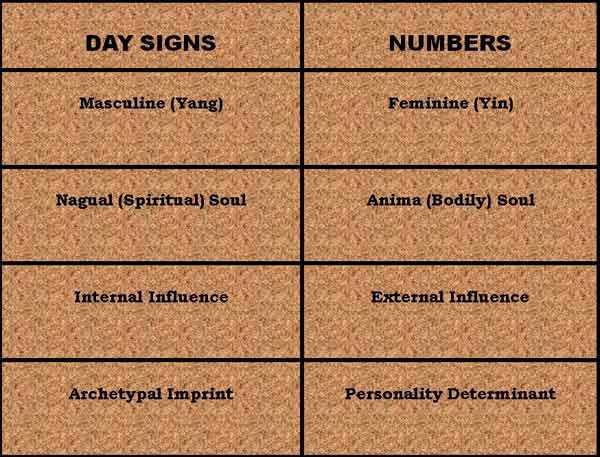 |
Lesson 2
Many people are unaware of how complex and detailed contemporary Mayan astrology can be. Part of the goal of this series is to introduce seekers to a bit of that complexity.
The most basic form of Mayan horoscope is the Mayan Cross, which is comprised of five signs. The cross is a very ancient symbol in Mayan culture; it is much older than Christianity. To the Classic Maya, the symbol of the cross was a World Tree or a Medicine Wheel. In fact, the four cardinal directions had the same meanings and the same color as they do among more northerly peoples: Red in the East, Yellow in the South, Blue or Black in the West, and White in the North. The Center is another direction, and in Mayan culture the center is blue-green, the color of precious jade. The Mayan Cross has survived 500 years of cultural oppression and is still in wide use. You can see it here on the head scarf worn by my friend Dona Maria; it identifies her Daykeeper lineage.
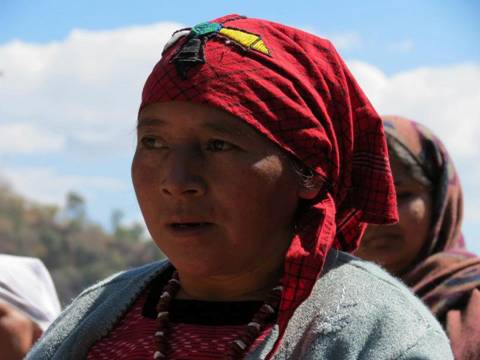
In order to get a sense of the Mayan Cross and its significance, here is a meditation:
Stand and face East, both of your arms extended from your sides as in a cross. Imagine that your future lies before you in the East, along with your children, all your descendants, and all your lives to come.
Behind you, in the West, are your ancestors and your own past existences. To your right, in the South, lie all your male qualities, as well as the men who cross your life’s path. On your left, in the North, lie your female qualities, including the women you encounter in life.
Now, imagine that your heart center, the very core of your inner World Tree, is occupied by the nawal or day-sign of your birth.
Behind you (West) is another day-sign, symbolic of your karmic past. (And yes, the Maya do believe in reincarnation.)
Ahead of you (East) lies a day-sign that is symbolic of your future.
On your right (South) is the Power of the Right Hand, a day-sign symbolic of the masculine or yang energies of your psyche.
On your left (North) is one more day-sign, the Power of the Left Hand, representing your feminine or yin energies.
Your day-sign of birth is the center of the cross, medicine wheel, or Tree of Life that includes five signs, one for each of the four directions and one for the center. Now we must discover which particular day-signs make up the other branches of your personal Tree of Life.
The four directional day-signs that accompany you and your basic birth-sign through life are found by a magical-mathematical formula that makes use of the numbers 7 and 9. Why do we use the numbers 7 and 9? 7 is a number of endings or death because each day sign sequence which begins with 1 will end with 7. 9 is the number of life because we all spend 9 months in the womb of the mother. As I was told by the well-known astrologer Roberto Poz of Zunil: “It requires both life and death to weave the complete tapestry of a human existence.”
Let’s use the example of an individual born on 13 Kawoq. To avoid confusion, let us remember that the Mayan Cross horoscope is presented in a kind of mirror image, so that right and left will seem to be reversed.
Count backwards nine days from 13 Kawoq until you reach 5 B’atz’. This is shown in the topmost position, representing the West, and is called your Conception Sign.
Count forward nine days from 13 Kawoq. This brings you to 8 Kej, the East, which is sometimes called your Future Sign, though in Guatemala I more often heard it called Signo de Destino or Destiny Sign.
Now, count backwards seven days from 13 Kawoq. This will bring you to 7 Aj. This is the Power of the Right Hand, symbolic of your masculine or yang energies.
Count forwards seven days from 13 Kawoq to 6 Kan, the Power of the Left Hand, symbolic of feminine or yin energies.
You now have a complete Mayan Cross. In our next lesson we shall learn what the different positions mean psychologically in your horoscope.
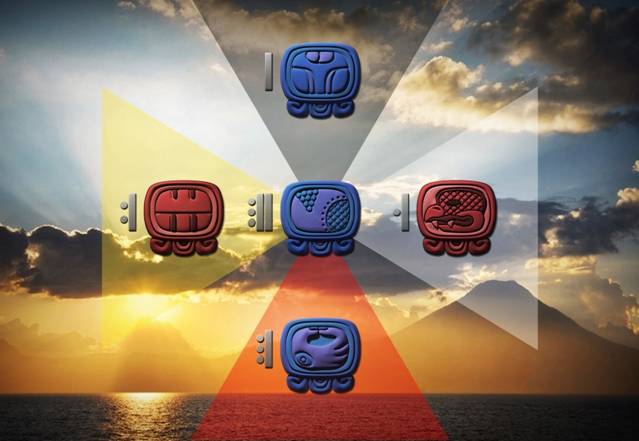
Lesson 3
Here are some very basic meanings of the five positions on the Mayan Cross horoscope:
The Heart Sign: This is the day sign of our birth — your nawal and “the face of your day.”Your day-sign is the center of the cross, medicine wheel, or Tree of Life. Your day sign is your archetypal imprint or spiritual identity. It is an inner influence rather than an outer one. It is the spiritual essence that underlies your outer personality, not the personality itself. Thus the day-sign or nawal may not always be the first thing that people notice about you; its power lies under the surface, deep in your innermost heart. In the Western world, it is normal for one to ask: “What’s your sign?” I can attest, from personal experience, that it is just the same among the Maya in Guatemala. I know the day-sign of birth for almost all of my Mayan friends, but I only know the number of birth for about half of them. If someone asks, “What is your nawal?” the customary reply will be “I was born on Imox,” or “My nawal is Tz’ikin.” Occasionally someone will answer in more detail and say, “I was born on 8 Tz’i,” but not always. The nawal or day-sign is commonly taken as the core factor of any Mayan horoscope.
The Conception Sign: This is the second most important factor in the Mayan Cross, next only to the day-sign and number of birth. The Conception Sign is symbolic of the months spent in the mother’s womb. It represents your pre-conscious experiences before birth, and as such it is the template of your family karma, both the immediate family of origin and your ancestral karma as well. The early experiences that shape you and provide you with an outlook on life – whether trusting and friendly or angry and uncertain – are all dependent to a certain degree upon the nature of your birth family. And yet these individuals, these family members, are likewise conditioned by the experiences they had in their own families, and so on and so on, back to the beginning. Since the Maya have a concept of reincarnation, it is by no means unusual to encounter Daykeepers who will say that the Conception Sign even represents your incarnational karma, the fruits of your former lives – which, after all, condition the nature of the life and hence the family into which will be born in the present incarnation.
The Destiny Sign or Future Sign: Together with the Birth Sign and Conception Sign, the Destiny Sign comprises the central column or “trunk” of your World Tree. Actualizing the Destiny Sign is a choice. For many, it will be enough simply to realize the full potential of their Birth Sign. To be able to look ahead, into the future, is a gift. The Destiny Sign symbolizes all those archetypal themes which it is both rewarding and appropriate for natives of our own day-sign to cultivate. The Destiny Sign is the seed for things to come. Using the materials characteristic of this sign, we may usefully shape for ourselves a vision of the future which is in accordance with the flow of our basic life pattern as established by the Birth Sign. In terms of material world manifestation, I have also found that the Destiny Sign often rather accurately describes our children (or at least some of them), for they are part of the future that we create for ourselves and for the world at large.
The Power of the Right Hand: As in so many other metaphysical polarity paradigms around the globe, the right side symbolizes the masculine or yang polarity of our existence. Some have described this sign as our way of functioning in the material world. It governs the way we reason and think, as well as the way we take (or do not take) strong, bold actions to realize our dreams and our desires. A forceful, positive day-sign combined with a balanced number in this position indicates an individual who can easily take charge of her or his destiny, maneuvering through the ups and downs of the material world with grace and skill. A challenging day-sign or difficult number here shows an individual for whom such skills do not come naturally and who must work in order to develop a useful way of functioning in the “real” world. I have also found that whether you are female or male, this sign will often indicate the character of the men who impact your life.
The Power of the Left Hand: This is the feminine or yin polarity of our lives. It symbolizes the quality of our intuition, our inner, mystical way of knowing. It governs the way we perceive emotionally and spiritually. If the sign which occupies this position is one which easily establishes connections with the “otherworld” all around us, we will have an innate talent to navigate the deep waters of the unconscious; we can rely upon our intuition to guide us. Challenging combinations here can lead to impulsive emotions, as well as illusions or apprehensions which interfere with the clarity of our intuition. I have also found that whether you are female or male, this sign will often indicate the character of the women in your life.
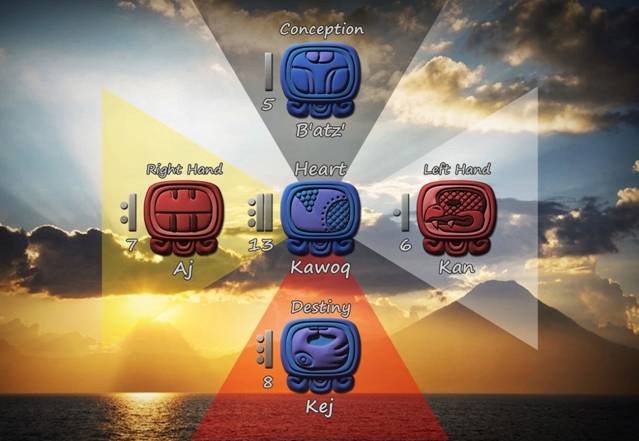
Lesson 4
The Mayan Cross, with its central birth sign and four arms, is the most basic form of Mayan horoscope. It is complete unto itself, but it can also be expanded into a more complex horoscope with nine signs.
As we have seen, Mayan numerology is quite different from Western numerology. Nine is “the number of life,” because we all spend nine months in the womb of the mother. The nine sign horoscope is based upon this principle.
So…If we begin with the five sign Mayan Cross, how do we find the other four signs? In order to find the Right Hand and Left Hand arms of the Mayan Cross, we counted seven signs backward and forward from the day sign of birth. The nine sign chart is constructed according to the same formula. We count seven signs backward and forward from the Conception Sign and from the Destiny Sign.
Now we have four more day signs, one at each corner of the horoscope. While some Mayan teachers assign special names and functions to these new day signs, others do not. And among those who do, there is a great deal of variation. In a primer such as this one, we need not complicate matters by going into detail. The important point is this:
We now have three columns: One in the center, representing the essence of our being, another to the right, representing what might be called the “yang” principle of logic, reason, and response to the practical world, and another to the left, representing the “yin” principle of intuition, emotion, and magic.
The central pillar, of course, remains exactly the same as in the Mayan Cross. But in addition to the masculine and feminine arms of the original Mayan Cross, we have now added other signs which provide much more psychological detail about the individual’s masculine and feminine polarities.
In addition to this, we have also constructed a time line, a way of understanding the principle phases of human life. In our next lesson, we will explore this idea.
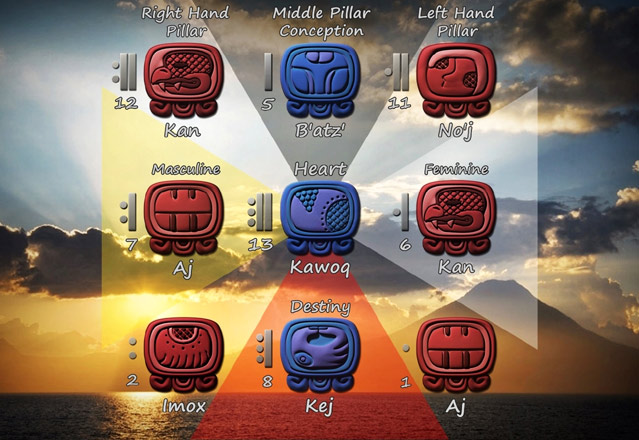
Lesson 5
Last time, we saw how the nine-sign Mayan horoscope can be read in three columns: A central column which describes the archetypal imprint of our essential being, a right hand or masculine column which indicates the skills and challenges of our rational, logical nature, and a left hand or feminine column which focuses on our feelings and intuition.
But if we read the horoscope as rows rather than columns, we are reading a time line. While the entire horoscope influences each and every moment of our lives, the various rows tend to act with greater prominence at various times in our lives.
I admit that there is some controversy about this. For example, when I was first studying the art in Xelahu and Momos back in early 2010, each row was commonly said to represent 26 years of life. But Mayan astrology is an art which is constantly in development, and in the intervening years I have heard many variations on the theme. The one I encounter most commonly at this time is as follows, and here we return to our 13 Kawoq example.
The first row is 12 Kan, 5 B’atz’, and 11 No’j. This describes our life circumstances between birth and the age of 13. The Conception Sign lies in the Middle Pillar, the column which forms the essence of our being, and earlier we said that the Conception Sign is “the template of your family karma, both the immediate family of origin and your ancestral karma as well.” Such influences play their strongest role when we are children.
The next row is 7 Aj, 13 Kawoq, and 6 Kan. This row relates to our life experiences between 13 and 35. In this row, dominated by our day of birth or Heart Sign, we come into “the prime of life,” and we are conscious of our true individuality.
The next row is 2 Imox, 8 Kej, and 1 Aj. This row dominates our lives between 35 and 52. The central column of our being is represented here by the Destiny Sign. These are the years of our so-called “midlife crisis,” when we question our purpose, our authenticity, our “destiny.”
When we reach the age of 52, something quite unique takes place in terms of the “magical mathematics” of the Mayan Calendar. Five years ago, when my studies began, there were no common charts or diagrams to show this important transition. Now we find a very unique addition to the repertoire of Mayan Astrology taking place, and this shall be the focus our next lesson.
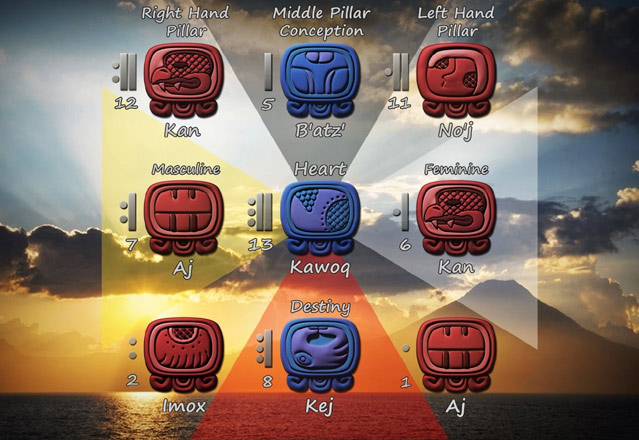
Lesson 6
The Mesoamerican Calendar is, in a sense, comprised of two calendars. There is the well-known tzolk’in (K’iche’ ch’ol q’ij) or Sacred Calendar of 260 days, and there is the 365 solar calendar, which is called haab in Yucatec or ‘ab in K’iche’. The two calendars also combine to produce a “lord of the year.” While this is a complicated topic, the simplest way to say it is that the New Year’s day of the solar calendar can only occur on one of four ch’ol q’ij days, and while many combinations have been used throughout the long history of Mesoamerica, the ones most commonly used in the present are Kej, E’, No’j, and Iq’.
So we are all born upon a certain combination of these three factors. How long will it take for the same combination – the same ch’ol q’ij day, ‘ab day, and year, to re-occur?
The answer is: 52 years. Somewhere close to your fifty-second birthday (with a few possible variations), the exact same combination of days which marked your birth will roll around again. In ancient times, this was known as a “Calendar Round,” and was celebrated by the Aztecs with fasting and prayer.
When I first began to study with Guatemalan teachers, this 52 year cycle was not marked by any special astrological factor. In recent years, however, Mayan astrologers have developed the practice of giving us a whole new horoscope to mark this important transition, sometimes called the 52 Year Horoscope or the Calendar Round Horoscope. Simply put, we progress the whole horoscope by 13 days. If I was born on 10 Imox, my 52 Year Horoscope will be 10 I’x. Using our standard example of a person born on 13 Kawoq, the 52 Year Horoscope will be 13 E’.
Some people seem to feel that the 52 Year Horoscope “replaces” the earlier one. This is not true. The day of our birth is our nawal, a word based upon the Nahuatl word nagual and referring to our indwelling, eternal spirit. This, of course, can never really change. It is who we are. The 52 Year Horoscope simply adds a new dimension to our beingness. It symbolizes a time when we become “larger” than we were before, when new roads, new possibilities, new potential experiences and revelations open up to us.
This may seem strange to some people, but it has a bearing upon the way that the Maya perceive life. In Western culture, we worship youth. If you are over 40, the young and the hip may well regard you as well on your way down the rocky road to stability. And just try getting hired for a job! Mayan culture is almost precisely the opposite. Youth may be vibrant and charming, but the young can be quite silly at times, due to their inexperience. Age is reverenced. Those who have reached a full Calendar Round are ready to become “tribal elders,” sages, mentors to their community. Astrologically, we acknowledge their growth in wisdom by acknowledging that such individuals are now ready to take on new ideas, new experiences, new paths of knowledge and wisdom, as symbolized by the 52 Year Horoscope.
When this concept was first presented to me by some of my teachers, I was skeptical. But I worked with it extensively over the course of a few years, and I have found that it works very well on a practical level, as well as adding new dimensions to the ways in which the time cycles of human life may be perceived through the horoscope.
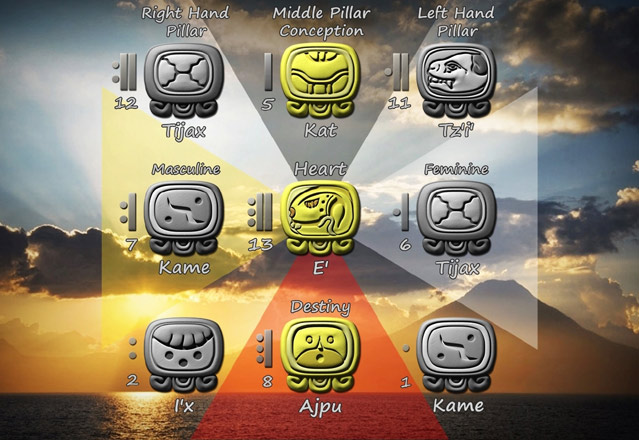
Lesson 7
The bolts of lightning which you see in this version of our example nine-sign horoscope are called “the Path of Feathered Serpent,” and they represent an entirely different, and very profound level of Mayan astrology, which charts the movement through the archetypal template of the birth chart of an energy that the K’iche’ Maya call the koyopa.
In common speech, koyopa means “sheet lightning” of the type which flickers above mountains and lakes. But this phenomenon of the natural world has its correspondence within the body; koyopa can also mean “the body lightning” or “the lightning in the blood.” Spiritual seekers who have spent time among the Maya have drawn attention to the close resemblance between the Mayan concept of koyopa and the Sanskrit kundalini. Both are connected with serpent imagery; yogic texts describe the kundalini as the “serpent power.” Bolts of lightning are regarded by the Maya as “sky serpents.” The archetype of the Feathered Serpent can appear in Mesoamerican myth as an historic Toltec teacher, as a god of the wind, and also as the koyopa, pure energy. This chart shows us how the pure energy of Feathered Serpent travels through our being.
The koyopa is the energy upon which shamans draw for important rituals, especially the divination ritual. The koyopa, like the kundalini, is a feminine power because it is associated with the 13 numbers of the sacred calendar, who are said to be the feminine partners or shaktis of the day signs. Koyopa collects in the thirteen major joints of the human body (wrists, elbows, shoulders, ankles, knees, hips and neck.
The koyopa dwells within the body and is connected with the bodily soul. As we noted in Lesson 1, the day signs are a masculine energy that represents the immortal soul or nawal, that which was known in the Nahuatl or Aztec language as the nagual, while the numbers are a feminine energy that represents the indwelling power of the bodily soul and its koyopa. If the koyopa is awake, the divine powers may contact us directly through our dreams, using the koyopa energy as a communicative medium between their world and ours.
We have seen that a Mayan Horoscope can be read in several ways:
– As a “cross of the four directions”
– As nine signs divided into three columns which represent our essence, our yang energies, and our in energies
– As nine signs divided into rows that chart the various phases of our lives
If we study which signs are linked by the lightning bolts of the koyopa energy that flows through our being, we can learn to recognize subtle connections which exist between the various day signs that are linked through this “path of the Feathered Serpent.” This is a highly intuitive way of reading the horoscope; it is best to attempt it after one has spent time working with the more fundamental methods of the Mayan Cross, the three columns, and the rows. But when one is capable of perceiving the deep links between day signs which are united by the path of the koyopa, new and deeper levels of meaning will emerge.
This method of reading a horoscope was developed by a group of esoteric astrologers in the city of Quetzaltenango. Their mentor and spiritual guide has never given me formal written permission to use his name, so I will not do so here. He is a professor at the Jesuit University in that city as well as a traditional Mayan aj q’ij and chuchqajaw or “mother-father.”
As vital as the Path of Feathered Serpent may be to a deeper and more esoteric understanding of the birth chart, it is not merely an intellectual construct. It is also a meditative tool for inner awakening; it is a spiritual practice. In the final (eighth) lesson, I shall explain how to use your horoscope as an instrument for spiritual development.
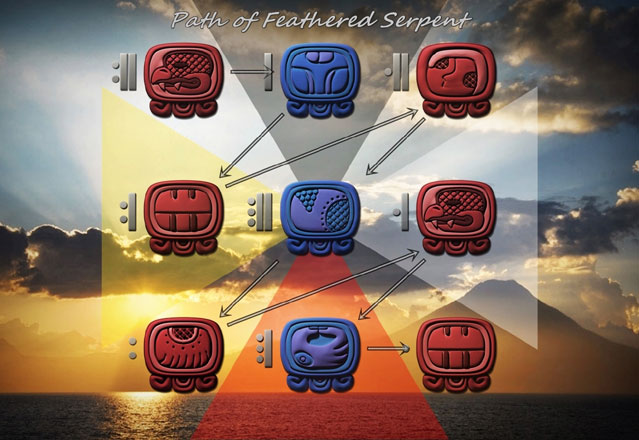
Lesson 8
Here is the technique for using one’s Mayan horoscope as a tool for meditation, traveling the “lightning bolt path” of the koyopa which we described in the previous lesson. Once every nine lunar months, the nine signs which make up our Mayan horoscope will recur in the sequence outlined by the lightning bolt path of the Feathered Serpent. From beginning to end, it will take 29 days for the entire horoscope to unfold. We may set aside these twenty-nine days as our own “personal lunar month.” This meditative technique originated among the same “esoteric” circle of Daykeepers in the city of Quetzaltenango mentioned in the previous lesson.
The meditation is called the Path of Feathered Serpent because of its connection with that archetype. However, there are at least three aspects of the Feathered Serpent in contemporary Mayan spirituality, and they are represented by three different day-signs:
Aq represents Feathered Serpent in his incarnation as the historical Toltec teacher Topiltzin Quetzalcoatl.
Iq’ represents Feathered Serpent in his aspect of the primal wind god, signifying the sacred breath within us.
Kan represents Feathered Serpent as pure energy, the “lightning in the blood” or koyopa.
The ultimate goal of the meditation relates to the Feathered Serpent archetype as Kan, for its purpose is to awaken and harmonize the koyopa.
Let us return to the example chart we have been using, that of an individual born upon the day 13 Kawoq. As we can see, the first day-sign to occur in the sequence will be 12 Kan. Then, several days later, the day 5 B’atz’ will occur, followed successively every few days by 7 Aq, 11 No’j, 13 Kawoq, 2 Imox, 6 Kan, 8 Kej, and finally, on the 29th day, 1 Aj.
The Mayan practitioners from whom I learned this meditation used to perform a complete fire ceremony on each of the nine days which made up their own lunar month. But if you were to attempt such a traditional Mayan ceremony in any apartment or suburban home in the Western world, your landlord would probably call the fire marshal and have you arrested.
Simpler versions of the same practices may suffice. Try to set aside a shrine or “sacred space” in your house, no matter how small. To honor the days, burn candles and light incense. Small candles are probably best.
There is no specific time of day when one must practice the meditations. Neither is there any specific length of time for which one must meditate. However, during (or after) the meditations, all candles and incense should be allowed to burn down to the end. In Mayan culture, the candles and incense are ofrendas or “offerings, and after all, an “offering” means that something is given up or surrendered. If you blow out the candle and keep it for yourself, it isn’t an offering.
Prayer is the most important element of all. The Mayan sacred text, the Pop Wuj, asserts that it is the gift of speech which sets human beings apart from their animal brethren. The appropriate use of speech is to employ all our innate eloquence and poetry to praise the beauty of the Blossoming World. This is the meaning of prayer to the Maya. Try to pray as well as meditate. Since there are specific topics for each meditation, it is often easy to combine deep reflection with silently spoken words of praise.
As one performs the prayers and meditations, giving thanks for the spiritual gifts represented by the day-signs, one should also meditate upon the question: How do the gifts of the various day-signs work in my own life?
